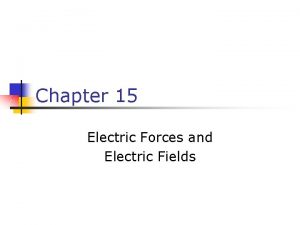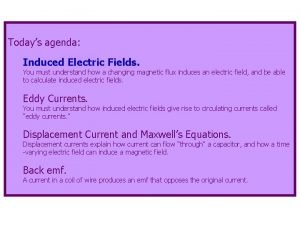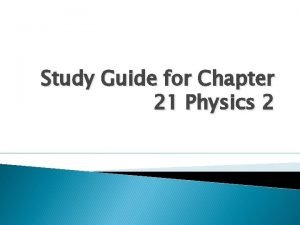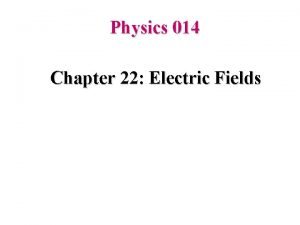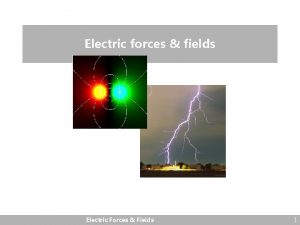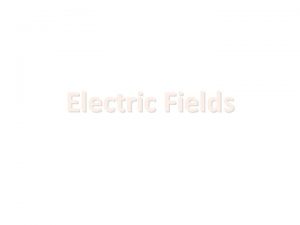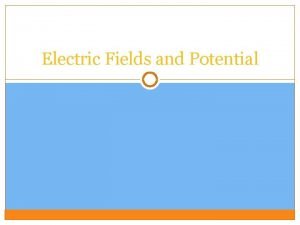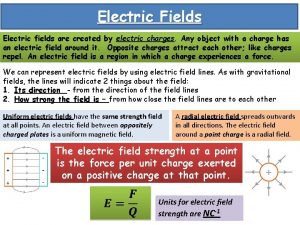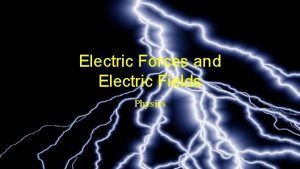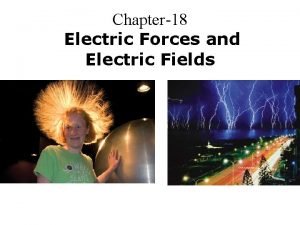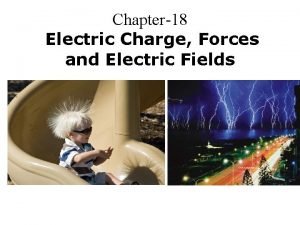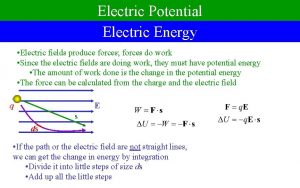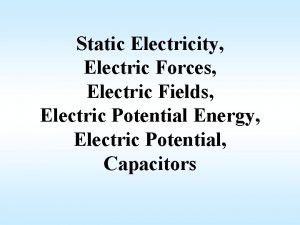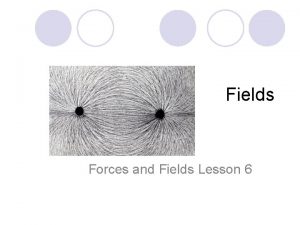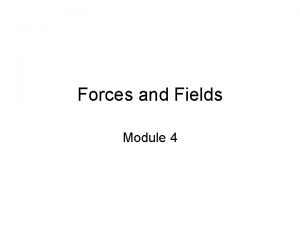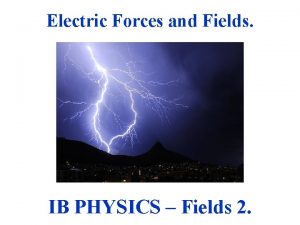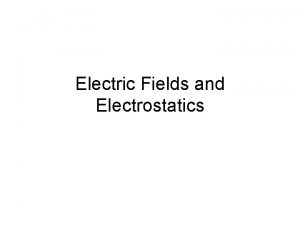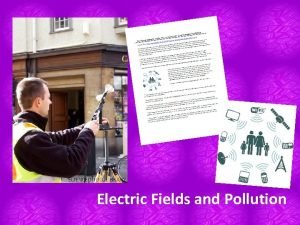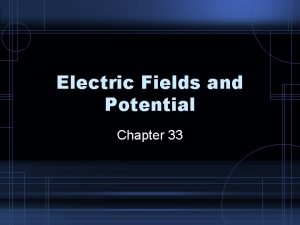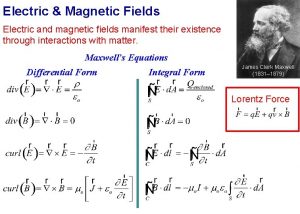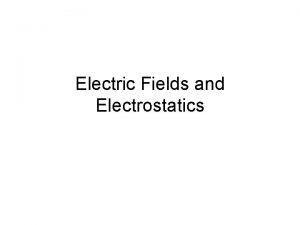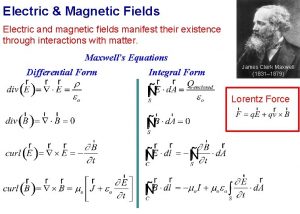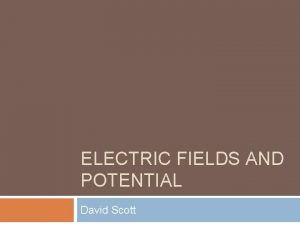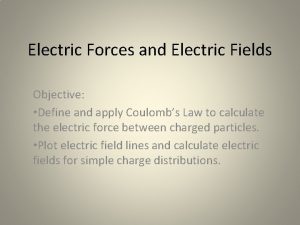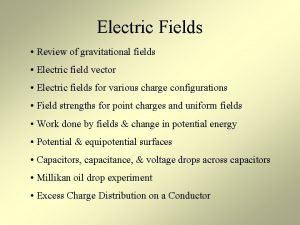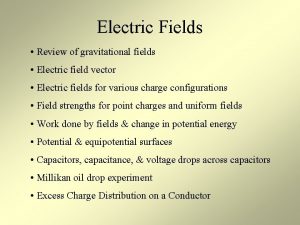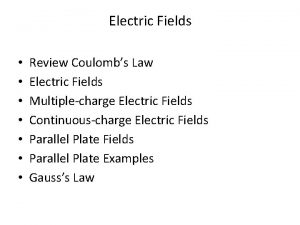Unit 2 Electric Fields and Forces Lesson 1


























- Slides: 26

Unit 2: Electric Fields and Forces Lesson 1

Objectives • explain electrical interactions in terms of the law of conservation of charge. • explain electrical interactions in terms of the repulsion and attraction of charges. • compare the methods of transferring charge ﴾conduction and induction﴿.

A Physics Story… • It was another bright and pleasant morning on the island of Crete. The birds sang a joyous morning song, welcoming the new day. The bees busily went from flower to flower, greeting each now pedal like a long lost friend. The sheep sat around and chewed their cud, which is about all that sheep ever really do anyhow, and inside his tiny hut, Putnamacles, typical Ancient Greek, woke up with his usual unexplained large shock to the head.

• Putnamacles is a Greek Philosopher, which means he sits around all day thinking thoughts about things that most people don’t bother ruffling their brows over. When he thinks a particularly good thought, he writes it down, for future generations to learn from. He doesn’t know it yet, but on this day, Putnamacles will discover something near and dear to us all here in the 21 st century. Putnamacles walked outside of his hut to a pond of water to glance at his reflection. He let out a disappointed groan. There was no denying it, Putnamacles had an Afro. And it was at least 2500 years until Ben Harper.

• The great philosopher began to wonder why his hair stood on end like this. Was it the will of the Gods? Probably, they had been screwing him about all month long. But what if it was the fault of something else. He began to ponder as he picked up his favorite sheep and started to comb it’s wool with his amber comb (amber, of course, not yet being realized as a plentiful source of dinosaur DNA).

• After a few moments of combing, Putnamacles noticed his amber comb started behaving strangely. It could pick up bits of dust and things from the ground which it couldn’t pick up before. The effect was really quite amazing. Putnamalces started to think about this phenomenon.

• He knew that there must be some sort of force of attraction between the comb and the dust at work. He knew the force: · Must be fairly strong, since it is strong enough to overcome the force due to gravity. · Was somehow created by rubbing the comb through the hair and eventually it went away. · Was dependant on distance, since the comb did not pickup the dust until it was sort of close up to it.

• Putnamacles decided to give this new force a name. He called it Elektron, which conveniently was also the Greek word for amber. • “Well, how do you like that. It wasn’t the gods after all. ” he said to his sheep.

• But just then a large lightning bolt fell from the sky and smote him but good. Now lets get back to Physics…

Conductors and Insulators: Grade 7 Review • Materials which allow electrons to flow through them easily are called conductors (ex: metals, tap water). • Materials that don’t allow electrons to flow through them easily are called insulators (ex. Amber, glass, rubber, plastics, pure water*). • Metals make good conductors because they have free electrons which are not bound to one atom in particular, and are free to flow.

Applications • Semiconductors: materials which are good conductors in some situations, good insulators in others (ex, silicon, selenium). Read page 514. • Superconductors: materials which allow charge to pass through them with very little to no resistance (ex. supercooled mercury). Read page 515.

• You’ve probably conducted simple experiments with electricity at home or in earlier science course, such as picking up bits of paper with a balloon. • You probably knew static electricity was at work when picking up those pieces of paper or frizzing up your hair. • Interesting note: combing your hair can build up to around 1000 volts of electricity, but virtually no current! Magic in Physics

Mythbusting! • Statement “ Static electricity is when electrons don‘t move anywhere". • Statement “ Static electricity is just like the stuff that runs light bulbs: only weaker. "

• MYTH! Electrons are always in motion! In fact, we can't even calculate their exact speed and exact position! In static electricity, there is just an imbalance and separation of charge. • MYTH! Lightning strikes are caused by static electricity, and they can pack up to 100 TW of power and 120 k. As of current! Even a charged balloon has in the thousands of volts of wattage. . .

Charge in the Atom • Matter is made up of atoms, and atoms are made up of three types of particles: · Positively charged protons · Negatively charged electrons · Neutral neutrons • In an atom, over all, the positive charges equal the negative charges and the atom is neutral.

• As you already know, opposite charges attract, while like charges repel. • This is very similar to a bar magnet (not a coincidence). • The computer applet shows the interaction between negatively charged particles (yellow) and positively charged particles (red). applet

• It is possible to remove some of these electrons from the atom. • If you've taken Chem, you know this can happen chemically. But here there is a physical component. How is this possible?

• When two dissimilar materials come into contact with one another, a chemical bond known as adhesion forms between the surfaces of the materials.

• When the materials are pulled apart, one material can ‘pull’ some stray electrons away from the other, thus the balance of electrons and protons will be upset.

Electric Charge • A way of measuring this difference in electrons is called electric charge. • Charge is given the symbol q and is measured in coulombs (C) • 1 coulomb of charge = 6. 24 x 1018 electrons (more on this number later. . . )

Creating Electric Charge • One way to create a charge is through friction.

Law of Conservation of Charge • So how is charge transferred from one object to another?

Conduction and Induction • Charge is transferred from one object to another by one of two ways: • Conduction – Electrons and charge are transferred between two objects by physical contact. • conduction • Induction – A charge transfer without physical contact, but by bringing a charged object near a neutral one. • induction

Conduction:

Induction

Charge Sharing • If two charged objects are same size/surface area and touch each other, add the two charges together and divide the net charge by 2 to find the new charge that each object now has (nature tends towards neutrality). • ex) A 5. 0 kg steel ball with charge of 4. 0 coulombs comes into contact with a neutral 5. 0 kg steel ball. What is the overall charge on each ball?
 Electric charges and electric forces lesson outline
Electric charges and electric forces lesson outline Electric forces and fields concept review
Electric forces and fields concept review Chapter 16: electric forces and fields answers
Chapter 16: electric forces and fields answers Red fields
Red fields Scrap heap magnet diagram
Scrap heap magnet diagram Chapter 33 electric fields and potential
Chapter 33 electric fields and potential Electric currents and magnetic fields
Electric currents and magnetic fields Visualizing magnetic field
Visualizing magnetic field Learning: module 26: magnetic forces and fields
Learning: module 26: magnetic forces and fields Electric fields quiz
Electric fields quiz Electric fields
Electric fields Electric fields
Electric fields Induced electric field
Induced electric field Chapter 21 study guide electric fields answers
Chapter 21 study guide electric fields answers Electric field for a disk
Electric field for a disk Electric field formula voltage
Electric field formula voltage Electric potential electric field
Electric potential electric field Electric potential class 12
Electric potential class 12 Chapter 21 electric charge and electric field
Chapter 21 electric charge and electric field Chapter 21 electric charge and electric field
Chapter 21 electric charge and electric field Electric force
Electric force Chapter 21 electric charge and electric field
Chapter 21 electric charge and electric field Like and unlike parallel forces
Like and unlike parallel forces What is contact force
What is contact force Balanced forces and unbalanced forces venn diagram
Balanced forces and unbalanced forces venn diagram Erosion is a destructive force that
Erosion is a destructive force that Electric potential from electric field
Electric potential from electric field









